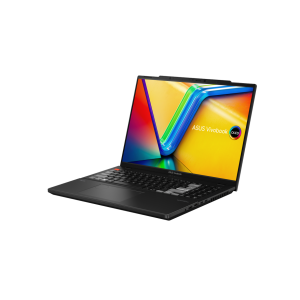Last night saw the debut of the 2023 range of Asus ROG laptops. Today our attention turns to Asus's non-gaming systems, including the first glasses-free 3D OLED laptops.
Asus's big announcement for CES 2023 is its new Spatial Vision display, the world's first glasses-free 3D OLED laptop display, allowing for immersive 3D experiences on a laptop with no wearables required. This is made possible using a lenticular lens and advanced eye-tracking camera technology, enabling the display to weave distinct images for each eye, resulting in an autostereoscopic 3D image. Users can also switch effortlessly between 2D and 3D. It is similar to the tech used for the 3DS, which also allowed for glasses-free 3D, but this time, you get a much sharper OLED panel to work with other benefits, like higher refresh rates (up to 120Hz) and better colour accuracy. This glasses-free 3D OLED technology integrates with the exclusive apps in the ASUS Spatial Vision Hub, which allows users to watch 3D videos and movies, play 3D games and access 3D visualisation apps.
There will be a few laptops sporting this OLED panel, including the ProArt Studiobook Pro 16 3D OLED and the Vivobook 16X 3D OLED.
On the Zenbook front, Asus is unveiling its most powerful Zenbook yet with the Zenbook Pro 16X OLED, the Zenbook Pro 14 OLED and the Zenbook 14X OLED. As you can tell from the names, each of these laptops packs a NanoEdge OLED display, and under the hood, you will find newly launched Intel 13th Gen Core mobile processors and RTX 40 series graphics.
Geared towards the business market, today Asus is also launching the ExpertBook B9 OLED, the first all-metal Asus laptop built using eco-conscious manufacturing technology. The new manufacturing process allowed Asus to reduce production materials by up to 29 percent, and shorten manufacturing time by 75 percent, thus helping to reduce the carbon footprint. Under the hood, you will find an Intel 13th Gen CPU supporting the Intel vPro platform. The laptop also packs a 2.8K display with 90% screen-to-body ratio, giving you plenty of resolution to work with while trying to multitask.
On the Chromebook front, Asus has now revealed the Chromebox 5, featuring an Intel 12th Gen Core CPU, Intel WiFi 6E technology for improved wireless performance, and funnily enough, the system also has a built-in 15W wireless charger, so you can top up for phone battery while using the system.
Additionally, Asus has also launched the Chromebook Vibe CX34 Flip, which uses a 16:10 144Hz WUXGA display, WiFi 6E technology and a full 360-degree hinge so you can use it in tablet mode. Under the hood you'll find an Intel 12th Gen Core i7, 16GB of memory and a PCIe SSD, as well as a battery capable of 10 hours of usage on a single charge.
There are also a few new Asus TUF laptops on the way, offering a mainstream alternative for a gaming laptop. The A16 Advantage Edition is an all-AMD powered system with a Ryzen 9 Zen 4 processor and an RDNA 3 GPU. The display offers 1440p at 240Hz and you can also configure it with up to 2TB PCIe SSD storage for speedy access to files and quick loading times.
Additionally, Asus has announced the TUF Gaming F15/17 and A15/17 laptops. Available with a 15-inch or 17-inch display, the F series houses up to an Intel 13th Gen Core i9 CPU while the A series houses an AMD Ryzen 9 Zen 4 CPU. These laptops also ship with newly launched RTX 40 series laptop GPUs, granting access to features like DLSS 3 to boost frame rates.
KitGuru Says: There are still more announcements to come from CES so stay tuned for more coverage, including video coverage from Luke and Leo, who landed in Vegas today to attend the show.
 KitGuru KitGuru.net – Tech News | Hardware News | Hardware Reviews | IOS | Mobile | Gaming | Graphics Cards
KitGuru KitGuru.net – Tech News | Hardware News | Hardware Reviews | IOS | Mobile | Gaming | Graphics Cards





